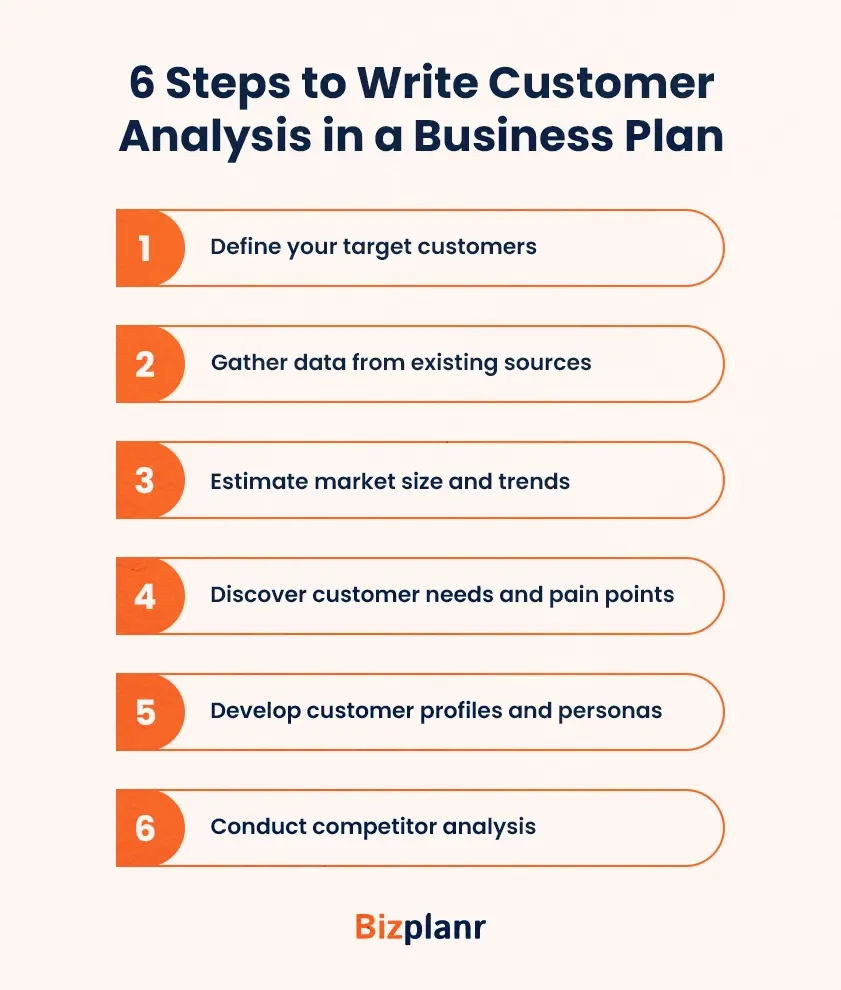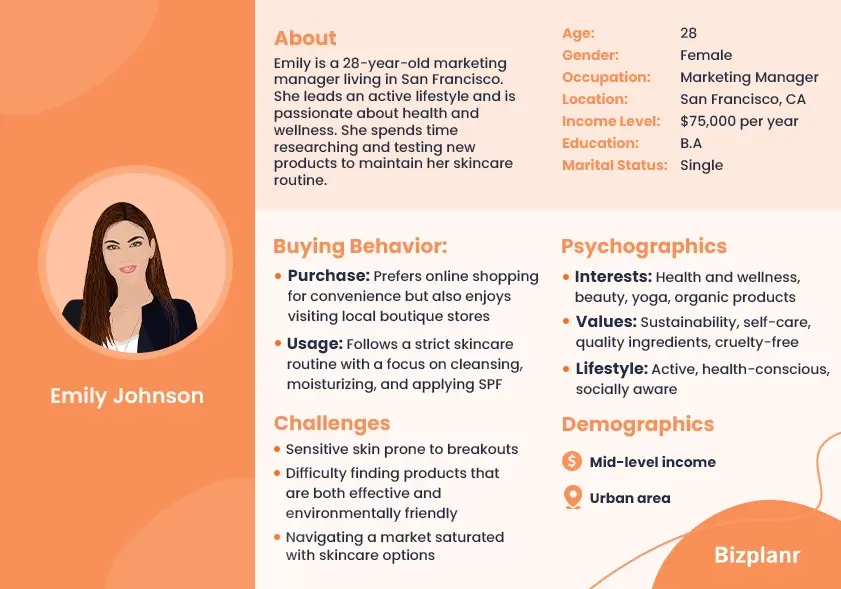"There is only one boss. The customer. And he can fire everybody in the company from the chairman on down, simply by spending his money somewhere else.” – Sam Walton.
So, everything a business does is for its customers. Because they’re central, customer analysis isn’t just any other section of the business plan.
It's the key section that determines what your product or service will be, who will buy it, and how you will target them.
But how do you write a customer analysis section for your business plan? Don't worry; here are six simple steps to guide you through writing this crucial section, along with an example.
Let's start by understanding what customer analysis precisely means.
What is customer analysis in a business plan?
Customer analysis in a business plan is a detailed look at your target customers, including their characteristics, needs, and buying behaviors. This analysis helps you understand your market better, customize your products and services to meet customer demands, as well as identify opportunities for business growth.
Why conduct customer analysis?
According to a Google survey, more than 40% of marketers use customer research and analysis to drive strategic business decisions.
Needless to say, there are multiple benefits to accurate customer analysis. Here are some of them:
- Helps in customizing marketing strategies for better customer engagement by understanding customer profiles.
- Assists in making informed decisions about product developments and improvements.
- Allows you to deeply understand customer needs reducing customer churn rate.
- Helps in identifying the pain points which supports gaining a competitive edge.
In short, the purpose of customer analysis in a business plan is to align your business strategy with the needs and behaviors of your target market.
6 steps to write customer analysis in a business plan
Now, that you understand why the customer analysis section is important, let's move forward with how to actually write one in 6 simple steps:
1. Define your target customers
The first step of customer analysis is to define and identify your target customers. Here are the steps on how to identify your target audience through market segment:
Customer demographics
Firstly define the age range of your customers (teenagers, young adults, seniors, or middle-aged). Then see to which gender your product or services appeal.
Also, consider the educational background, occupation, and income level of the target customers.
Psychographics
The psychological and emotional factors affecting the choice of a consumer are known as psychographics. It includes analyzing the lifestyle of your consumers.
Likewise, identify the core values of your customers like do they seek affordability, quality, or sustainability. Try to understand the interests of your customers too.
Geography
Here, mention the location of your customers. Are they situated in urban, suburban, or rural areas? Additionally, look if the weather affects the demand for your product or service. If it does, then consider the weather of the particular location.
Purchasing behavior
Understand the customer behavior whether they prefer to buy things online or through physical stores. Do they think twice before buying any product or purchase it recklessly?
Additionally, consider whether your target audience sticks to a brand or switches it frequently.
Use of technology
Technographic segmentation can help companies to identify the applications and motives for purchasing. Here is how you can create technographic segments:
- Find out what technologies your customers use with surveys, web analytics, or third-party data providers.
- Identify key technographic variables (consumers' technology usage behaviors) such as hardware, software, technology stack, etc.
- Segment your audience based on essential variables such as device-based, tech savviness, usage intensity, etc.
2. Gather data from existing sources
The next step is to identify sources for gathering relevant data. Start with your internal data, which may include customer statistics such as age, gender, location, and contact numbers.
Here are some ways:
- Google Analytics: It’s an excellent tool for tracking user activities across your website including age, gender, interests, traffic sources, buying behavior, and more.
- Social media metrics: Instagram insights, Facebook insights, and others provide you with demographic information and visitor tools.
- U.S. Census Bureau: You should seek population statistics like age, gender, and race. Then search for average incomes, number of businesses, and employment figures in local communities.
3. Estimate market size and trends
Once you know the target audience, estimate the market size for your product and the number of potential customers from your target market.
You can use existing data from industry reports, market research data, and statistical resources to support your estimates.
Also, analyze the current trends affecting your target market. It includes technological advancements, economic factors, cultural shifts, or other relevant trends.
4. Discover customer needs and pain points
The next step is to specify the needs and challenges of your target audience. Getting to know what exactly your customers need helps you understand whether your product or service is fitting or not.
Some of the ways to do it are:
- Engage directly with potential customers - Engage directly with customers as it is a reliable and affordable way to know about their needs.
- Collect customer support data - Gather direct customer data from the customers who had any issue with your product or service to better understand their pain points.
- Review customer feedback - Check all the Google reviews and social media platforms for direct customer feedback to understand more about what kind of products or services are they seeking.
5. Develop customer profiles and personas
After all the research, it’s now time to create a customer profile. It includes all the characteristics of the type of audience you’re planning to target.
These personas enable businesses to understand customers more deeply. It allows businesses to tailor marketing efforts and product development to meet their needs better.
Here’s an example of a persona profile for a skincare company:
6. Conduct competitor analysis
Identify your potential competitors and analyze how they meet their customer needs. Evaluate their strengths and weaknesses in comparison to your offerings.
Determine where your competitors stand in the market and how they segment their customer base. This will help you identify opportunities and gaps in the market.
With all the competitor research data, you can craft a marketing plan to target customers differently than competitors, helping in identifying unique selling points.
So, these were the six simple steps, and to understand it further, let’s get forward with the example.
Customer analysis example of an online sustainable clothing retail store
Target market overview
- Demographic Segmentation: Women aged 18-35; Men aged 18-35; College-educated; Students and young professionals.
- Geographic Segmentation: Urban areas in the U.S.; Major cities like New York, Los Angeles, and Chicago.
- Psychographic Segmentation: Environmentally conscious; Interested in fashion and trendy styles.
- Behavioral Segmentation: Regular online shoppers; Prefer eco-friendly products; willing to pay a premium for sustainability.
Target customer profile
Primary Target Customer:
Secondary Target Customer:
Customer needs and preferences
Customer Needs:
- High-quality, sustainable fashion products
- Easy online shopping experience
- Reliable and fast shipping options
- Transparent information about product sustainability.
Buying Preferences:
- Prefer online shopping via website and social media
- Detailed product descriptions and reviews
- Attracted to brands with strong ethical and environmental values
Market Size and Growth
| Metric | Value |
|---|---|
| Market size | $6 billion (U.S. sustainable fashion market) |
| Market growth | 10% annual growth rate |
Customer Buying Behavior
Buying Process:
- Discover through social media and online ads
- Visit the website, browse products, read reviews, compare options
- Follow the brand on social media, engage with content
Decision-Making Factors:
- Product quality and sustainability
- Brand reputation and ethical values
- Positive reviews and word-of-mouth
- Price and value for money
Competitive Landscape:
| Competitor type | Examples |
|---|---|
| Direct competitors | Reformation, Patagonia, Everlane |
| Indirect competitors | Zara, H&M (eco-friendly lines) |
This comprehensive customer analysis example will help align business strategies with customer needs, drive growth, and build a loyal customer base.
Conclusion
In the end, understanding and prioritizing the customer is necessary for any business's success.
Customer analysis is not merely a section in your business plan; it influences product development, marketing strategies, and overall business growth.
And we hope you can write this crucial section effectively with this article. But if you're still unsure about formatting and presentation, consider using an AI business plan generator.
This tool can help you create a comprehensive customer analysis section and complete your entire business plan within minutes.
Happy planning!
Get Your Business Plan Ready In Minutes
Answer a few questions, and AI will generate a detailed business plan.
Frequently Asked Questions
What are the most important customer metrics to track?
The most important customer metrics to track include:
- Customer acquisition cost (CAC)
- Customer lifetime value (CLV)
- Churn rate
- Customer retention rate
- Customer satisfaction score (CSAT)
- Average revenue per user (ARPU)
- Repeat purchase rate
Tracking these metrics helps you understand customer behavior, improve satisfaction, and drive business growth.
What common mistakes should be avoided in customer analysis?
Common mistakes to avoid in customer analysis include:
- Ignoring data quality: Ensure your data is accurate and up-to-date.
- Overgeneralizing customer segments: Avoid lumping diverse customers into broad categories.
- Neglecting qualitative insights: Balance quantitative data with qualitative feedback.
- Focusing solely on demographics: Consider psychographic and behavioral factors as well.
- Not updating analysis regularly: Regularly review and update your analysis to reflect current trends.
- Overlooking competitor insights: Consider how competitors influence your customers.
Avoiding these mistakes will lead to more accurate and actionable customer insights.
What are the most effective methods for collecting customer data?
The most effective methods for collecting customer data include surveys, website analytics, social media monitoring, customer feedback forms, purchase history, customer reviews, etc.









